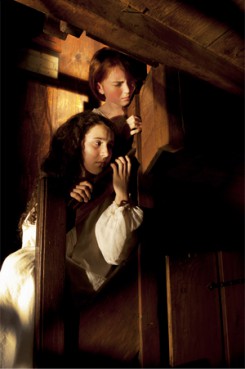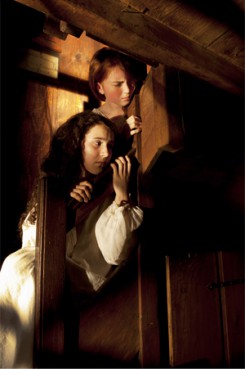
(RNS2-NOV08) Girls caught up in the fervor of the 1692 Salem witch trials are seen in “Salem Witch Hunt: Examine the Evidence,” a new film about the Salem Witch Trials. For use with RNS-WITCH-TRIALS, transmitted Nov. 8, 2011. RNS photo courtesy Essex National Heritage Commission and Don Toothaker.

(RNS2-NOV08) Girls caught up in the fervor of the 1692 Salem witch trials are seen in “Salem Witch Hunt: Examine the Evidence,” a new film about the Salem Witch Trials. For use with RNS-WITCH-TRIALS, transmitted Nov. 8, 2011. RNS photo courtesy Essex National Heritage Commission and Don Toothaker.
SALEM, Mass. (RNS) For centuries, scholars have wondered how a farming village in 1692 could have become so hysterically anxious that magistrates would order 20 executions for crimes of witchcraft.
Now a new documentary film about the infamous Salem Witch Trials is stirring fresh debate by heaping blame on the local minister, the Rev. Samuel Parris.
Scholars agree that Parris played a central role, but they’re divided on whether he deserves the villainous treatment he receives in the film, “Salem Witch Hunt: Examine the Evidence.”
The 35-minute film began showing four times daily last month at the Salem Maritime National Historic Site. Five leading scholars collaborated with the Essex National Heritage Commission, producer of the film, which draws heavily on a recent compendium of nearly 1,000 documents from the period.
“We finally have a chronology that tells us about how it all began,” said University of Virginia historian Benjamin Ray, one of four scholars who took questions after a recent screening. “Before we had documents, but we didn’t have an orderly sequence. It’s hard to give an account of history without a sequence.”
In reviewing sermons, journals and court records, scholars began to see how various pieces fit together. Everywhere they looked, they seemed to find fingerprints — both figuratively and literally — of Parris and his ally, Thomas Putnam, a wealthy landowner and church member.
The story begins with a community that feels under siege. Reeling from bloody Indian wars and wary of encroaching French Catholics, residents of rural Salem Village feared the Puritan experiment in America’s colonies might be nearing a violent end. Into this tinderbox comes the newly ordained Parris, a 36-year-old Harvard dropout who’d been a serial failure in farming and business enterprises.
“This is really his last chance to succeed,” says Salem State University historian Emerson “Tad” Baker in the film. “He can’t fail at this because if he does, he’s really kind of failed at life.”
Desperate for an accomplishment, Parris revives rigorous church standards in a bid to stoke a religious revival, according to the film. His fervor heightened tensions between church members and the “reprobate,” or nonmembers. When he warns in sermons of an unfolding battle between good and evil, conditions ripen for accusations to fly.
Trouble begins in Parris’ own family. After his niece and daughter start acting strangely, the girls cite two local women for cursing and tormenting them. Parris later pressures Tituba, his slave, to confess before the magistrates. Tituba warns them: nine witches remain at large. The hunt intensifies across all levels of society. Even church members are accused.
At various junctures, it seems, Parris could have called for cooler heads to prevail. But he had his own motives to continue the hunt, according to Cornell University historian Mary Beth Norton.
“He wanted to become like Cotton Mather,” Norton says in the film, referring to the prominent Boston minister who had become known for describing children afflicted by alleged witchcraft.
Parris lets accusations and trials continue, with help from Putnam, who continually revises court records to make the accused seem guilty. Parris asks forgiveness within a few years of the last trials. He died in 1720, having never found the success he sought, according to the film.
Though scholars worked together on the film, not everyone likes how Parris comes across. One critique: the film could have shown more compassion and understanding for a struggling man who faced enormous, sometimes competing pressures.
“I thought it was a little over the top the way the film portrayed him,” said Richard Trask, a historian and archivist at the Danvers Archival Center, which preserves records from the witch trials. “Parris is much more than the bad guy.”
Indeed, Salem residents are still trying to make sense of their region’s infamous past and Parris’ role in it.
“For years, I always had thought of him as fiercely intoxicated with power,” said Peter Santos of Salem. “I now really believe that he was a tragic hero. He believed he was God’s right-hand man, doing all within his power to protect his fellow Christians.”
Parris’ role isn’t the only new insight from the film. Tituba’s ethnic identity is revealed to be Native American (in other renderings, including Arthur Miller’s 1952 play “The Crucible,” Tituba is African). Also, many of the 150 accused in the region during the 1690s came from nearby Andover, not Salem Village.
“They should really be known as the Andover Witch Trials,” Baker said.
Scholars are also casting doubt on the popular idea that those executed in 1692 were principled heroes who refused to repent for a crime they didn’t commit. In fact, the accused had no reason to believe a confession would save their lives, according to Margo Burns, a linguist and expert on period documents at St. Paul’s School in Concord, N.H.
What filmgoers are apt to remember, however, is the minister’s prominent role. Whether they’ll give him credit for repenting, or only for escalating hysteria, remains to be seen.
In a written confession, Parris “basically says, God had spit in his face, and he deserved to be lied low in the dust of humiliation,” Trask said. “Even some of his enemies said, ‘If you’d only said that a year or two ago, things would be different. But it’s too late now.'”




